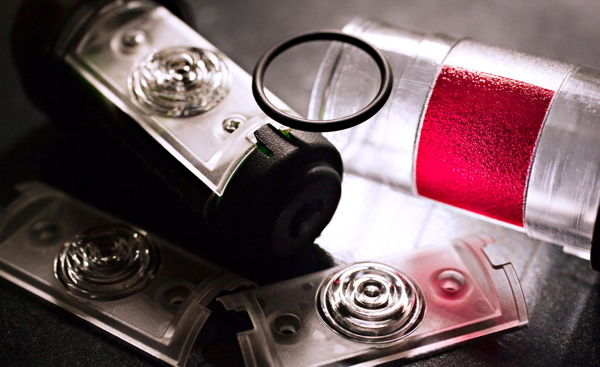Polycarbonate is an amorphous thermoplastic with a fantastic balance of properties. It is stiff, strong, has good ductility and exceptional impact resistance. While it does have some notch sensitivity (as do most thermoplastic materials), in solid or sheet form the impact resistance of PC is unmatched. (As an example, thermoformed PC is used for the cockpit canopy of several fighter jets, including the F-22 Raptor). If your application involves any kind of impact, polycarbonate should be on your short list of materials to consider.

light shield with lens and tubular body – both in PC
Polycarbonate was commercialized in the 1950’s, having been invented at almost the same time by GE Plastics in the US and by Bayer in Germany. GE marketed the material under the trademark Lexan®, while Bayer marketed the material under the tradename Makrolon®. Polycarbonate is used in a wide variety of applications, including appliance housings, football helmets, automotive headlights, and CD and DVD discs.
In addition to its physical properties, polycarbonate is also easy to process, and can be made in sheets. In this form it is widely used in the construction indusrty, especially for large windows and architectural lighting applications.
The optical properties are similar to PMMA, with slightly lower optical clarity. However, it does have a higher refractive index, so lenses in PC can often be made thinner than in other materials (including PMMA). In eyeglasses, this allows for thin, lightweight lenses. In addtion, the exceptional impact resistance of polycarbonate is an added safety feature.
I sometimes think of polycarbonate as comparison material.
“It’s kind of like acrylic, but with better physical properties.” (and its much more expensive)
“It has a balance of properties like ABS, but with better toughness.” (and it can be made clear)
“It has properties similar to nylon, but it is amorphous.”
While none of these descriptions truly do it justice, they may help you better understand the unique characteristics of this material.







Want to hear more from plastics guy?
Sign up for a monthly update of our latest posts.
You have Successfully Subscribed!